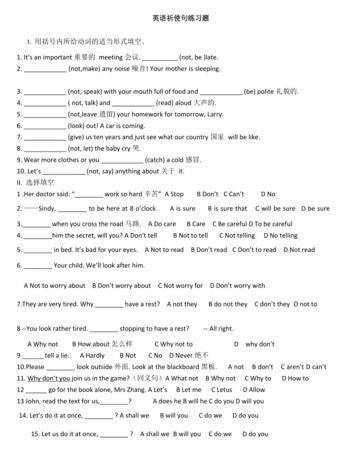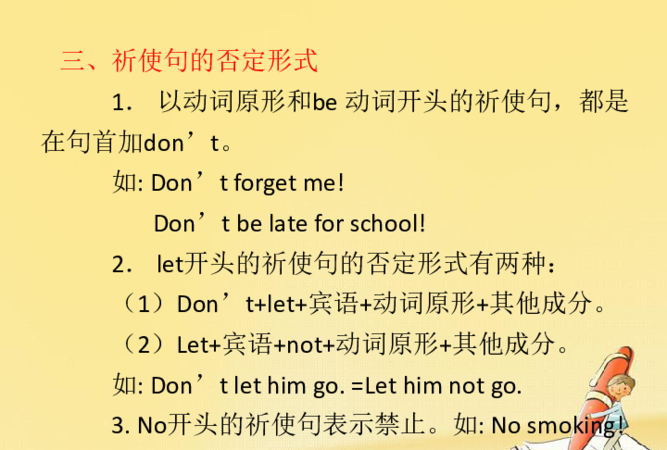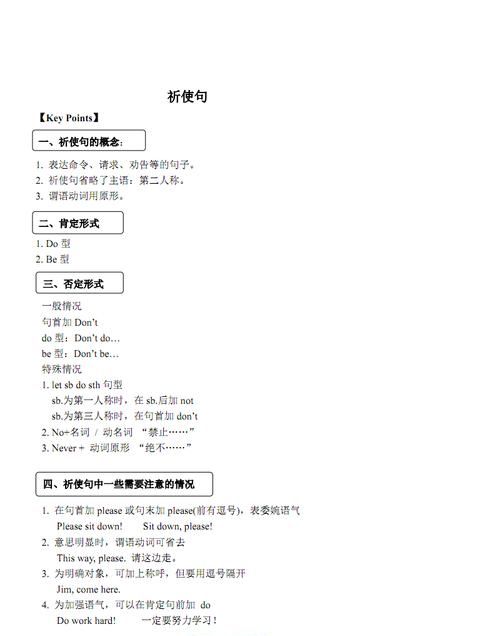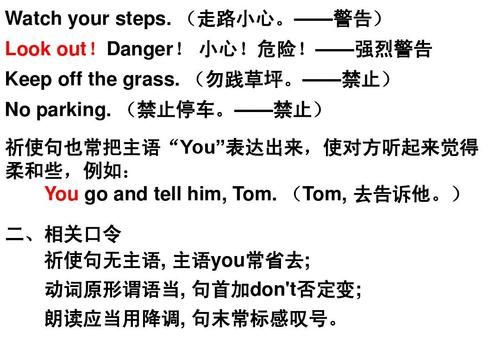本文目录
初一下册英语12单元单词
Unit 12 Don’t eat in class. 短语 1. arrive / belate for class 上课迟到 2. run in the hallways 在走廊里跑 3. eatoutside 在外就餐 4. wear a uniform 穿制服 5. have to do 不得不 / 必须做。。。 6. what / who /where / nothing / someone else 其它什么/别的什么人/别的什么地方/没有别的什么东西/别的某人 7. on schoolnights 在有课的晚上 8. practice the guitar 练习吉它 9. too manyrules 太多的规矩 10. by ten o’clock 在10:00以前 11. Don’t listento music in the classroom. 不要在教室里听音乐。 12. Do your homework after school. 放学后做作业。 13. No talking. 不许讲话。 No food. 禁止带食物。 14. – Do you have to wear a uniform atschool? -- Yes, we do. --你们必须在学校穿制服吗? -- 是的,必须穿。 15. After school, we have to clean theclassroom. 放学后,我们必须打扫教室。 16. I never have any fun. 我从来没有任何快乐。 17. talk loudly 高声喧哗 语法:祈使句 祈使句表示请求、命令、叮嘱、劝告等,谓语动词用原形。例如: Come in, please.请进。 Do your homework at once.马上做你的作业。 Don’t be late for school again.上学别再迟到了。 Take care not to catch a cold.小心别感冒了。 Get out!滚! Look out! Mind your head!小心!当心头! 这种句子的否定式多用Do not(通常写为Don’t)引导,也可用Never引导。例如: Don’t sit on the desk.不要坐在桌子上。 Don’t watch TV too much.不要看太多的电视。 Never do that again.再不要这样做了。 祈使句的主语通常是不表示出来的。例如:Don’t worry. I’lllook after myself. 在句型转换中, 肯定祈使句:DO +do / be… 否定祈使句:Don’t do / be…

初一英语下册语法知识点全汇总
一. 词汇
⑴ 单词
1. 介词:in, on, under, behind, near, at, of
1). in表示"在……中", "在……内"。例如:
in our class 在我们班上
in my bag 在我的书包里
in the desk 在桌子里
in the classroom 在教室里
2). on 表示"在……上"。例如:
on the wall 在墙上
on the desk 在桌子上
on the blackboard 在黑板上
3). under表示"在……下"。例如:
under the tree 在树下
under the chair 在椅子下
under the bed 在床下
4). behind表示"在……后面"。例如:
behind the door 在门后
behind the tree 在树后
5). near表示"在……附近"。例如:
near the teacher's desk 在讲桌附近
near the bed 在床附近
6). at表示"在……处"。例如:
at school 在学校
at home 在家
at the door 在门口
7). of 表示"……的"。例如:
a picture of our classroom 我们教室的一幅画
a map of China 一张中国地图
2. 冠词 a / an / the:
冠词一般位于所限定的名词前,用来署名名词所指的人或事物。冠词有不定冠词和定冠词两种。不定冠词有两个形式,即a和an。a用在以辅音音素开头的词前,如a book; an用在以元音音素开头的字母前,如an apple.
a或an与可数名词单数连用,泛指某类人或某物中的一个。
This is a cat.
这是一只猫。
It's an English book.
这是一本英语书。
His father is a worker.
他的爸爸是个工人。
the既可以用在可数名词前,也可以用在不可数名词前,表示某个或某些特定的人或事物,也可以指上文提到过的人或事物。
Who's the boy in the hat?
戴帽子的男孩是谁呀?
------ What can you see in the classroom?
------ I can see a bag.
------ Where's the bag?
------ It's on the desk.
------- 你能在教室里看到什么呀?
------ 我能看见一个书包。
------ 书包在哪呀?
------ 在桌子上。
3.some和any
①在肯定句中用some.例如:
There are some books on the desk.桌子上有一些书。
Lucy has some good books露西有一些好书。
②在疑问句和否定句中用any。例如:
Is there any ink in your pen?你的钢笔里有墨水吗?
Do you have any brothers and sisters?你有兄弟姐妹吗?
There isn't any water in the glass.杯子里没有水。
⑵记住它们的特殊用法。
①some亦可用于表示盼望得到对方肯定的答复或表示建议、委婉请求的疑问句中,这一点我们不久就会学到。例如:
Would you like to have some apples?你想吃苹果吗?
②any也可用于肯定句中,表示"任何的"。例如:
Any one of us can do this.我们当中任何一个都能做这个。
some 和any的用法是经常出现的考点,希望大家能准确地掌握它们的用法。
4.family
family看作为一个整体时,意思是"家庭",后面的谓语动词be用单数形式 is ;如把family看作为家庭成员时,应理解为复数,后面的谓语动词be应用are。
My family is a big family. 我的家庭是个大家庭。
My family are all at home now. 我的家人现在都在家。
Family强调由家人组成的一个集体或强调这个集体中的成员。home指个人出生、被抚养长大的环境和居住地点。 house指"家"、"房屋",侧重居住的建筑本身。
His family are all workers. 他的家人都是工人。
My home is in Beijing. 我的家在北京。
He isn't at home now. 他现在不在家。
It's a picture of my family. 这是一张我全家的照片。
5. little的用法
a little dog 一只小狗,a little boy 一个小男孩。little常用来修饰有生命的名词。
*但little还可表示否定意义,意为"少的",加不可数名词。
There is little time. 几乎没时间了。
There is little water in the cup. 杯中水很少。
⑵ 词组
on the desk 在桌子上
behind the chair 在椅子后
under the chair 在椅子下面
in her pencil-box 在她的铅笔盒中
near the door 在门附近
a picture of a classroom 一个教室的图片
look at the picture 看这张图片
the teacher's desk 讲桌
a map of China 一张中国地图
family tree 家谱
have a seat 坐下,就坐
this way 这边走
二. 日常用语
1. Come and meet my family.
2. Go and see. I think it's Li Lei.
3. Glad to meet you.
4. What can you see in the picture?
I can see a clock / some books.
5. Can you see an orange?
Yes, I can. / No, I can't.
6. Where's Shenzhen?
It's near Hong Kong.
7. Let me see.(口语)让我想想看。
see 在这是"明白、懂了",不可译作"看见"。例如:
8. Please have a seat.
seat表示"座位",是个名词。have a seat表示"就坐",也可以说take a seat, 和sit down的意思相同。
三. 语法
1. 名词所有格
名词如要表示与后面名词的所有关系,通常用名词所有格的形式,意为"……的"。一般有以下几种形式:
(1). 一般情况下在词尾加"'s"。例如:
Kate's father Kate的爸爸
my mother's friend 我妈妈的朋友
(2). 如果复数名词以s结尾,只加"'"。例如:
Teachers' Day 教师节
The boys' game 男孩们的游戏
(3). 如果复数名词不以s结尾,仍加"'s"。例如:
Children's Day 儿童节
Women's Day 妇女节
(4). 表示两个或几个共有时,所有格应加在后一个名词上。例如:
Lucy and Lily's room Lucy 和Lily的房间
Kate and Jim's father Kate 和Jim的爸爸
动物和无生命事物的名词的所有格一般不在词尾加"'s",而常常用介词of的短语来表示。
a map of China 一幅中国地图
the name of her cat 她的猫的名字
a picture of my family 我的家庭的一张照片
the door of the bedroom 卧室的门
2. 祈使句
祈使句主要用来表示说话人的请求、命令、建议、叮嘱等意图。祈使句一般不用主语,读时用降调。为使语气委婉、礼貌,常在句首或句尾加please 。在句尾时,please前多用逗号。
(1). 祈使句肯定形式的谓语动词一律用动词原形。
Go and see. 去看看。
Come in, please. 请进。
(2). 祈使句的否定形式常用don't于句首。
Don't look at your books. 不要看书。
Don't play on the road. 不要在马路上玩。
3. There be 的句子结构
There be是一个"存在"句型,表示"有"的意思,
肯定句的形式为:There be + 名词(单数或复数)+地点状语或时间状语。
be动词单复数的确定,看be后边第一个名词,当所接主语为单数或不可数名词时,be动词形式为is;当所接主语为复数名词时,be动词为are;当be动词后接两个以上主语时,be动词与最临近主语保持数上的一致。意思为"某地有某人或某物"。如:
There is an eraser and two pens on the desk. 桌子上有一块橡皮和两支钢笔。
There are two pens and an eraser on the desk. 桌上有两支钢笔和一块橡皮。
(1)there be的否定句,即在be的后面加上not。
否定形式为:There be + not + (any) + 名词+地点状语。
There is not any cat in the room. 房间里没猫。
There aren't any books on the desk. 桌子上没书。
(2)there be句型的疑问句就是将be提到句首:Be there + (any) +名词+地点状语?肯定回答:Yes, there is / are. 否定回答:No, there isn't / aren't.
---Is there a dog in the picture? 画上有一只狗吗?
---Yes, there is. 有。
---Are there any boats in the river? 河里有船吗?
---No, there aren't. 没有。
(3)特殊疑问句:How many . . . are there (+地点状语)?"某地有多少人或物?"回答用There be . . .
There's one. / There are two / three / some . . .
有时直接就用数字来回答。One. / Two . . .
---How many students are there in the classroom? 教室里有多少学生?
---There's only one. / There are nine. 只有一个。/有九个。
(4)如果名词是不可数名词,用:How much + 不可数名词 + is there + 地点状语?
How much water is there in the cup? 杯中有多少水?
How much food is there in the bowl? 碗里有多少食物?

英文里的祈使句是什么意思
祈使句 一、定义 祈使句是英语的基本句型之一,表达说话人对对方的叮嘱、劝告、请求或命令等,往往有表示请求、命令、希望、禁止、劝告等意思。 祈使句一般没有主语,实际上是省略了主语“You”。句末用感叹号或句号,用降调朗读。肯定结构都以动词原形开头。例如: Catch the ball!接球!(句子的意思是让“你”接球) Go and ask the teacher. 去问问老师。 句子的意思是让“你”去问老师。 Put the books in your bag. 把书放到书包里。 Come and meet my family. 来看看我家人。 二、句型 1. 祈使句的肯定句式有三种形式,即 1)Do型(以行为动词原形开头),例如: Sit down 坐下! Stand up 起立! 2)Be型(以be开头),例如: Be quiet 安静! 3)Let型 (以let开头), 例如: Let me help you. 让我来帮助你。 注意:三种句型中Do型是最常见、最简单的一种结构。表示请求、劝告的祈使句还常常在句前或句末加上Please, 构成句式:Please...或...Please. 以使语气更加缓和或客气。例如: Please stand up.或Stand up,please.请站起来。 Please have a rest.或Have a rest,please.请休息一下。 2. 祈使句的否定结构是以“Don't+动词原形”开头。例如: Don't go there,please. 请别去那儿。 Don't be late. 不要迟到。 Don't let him in. 不要让他进来。 Don't let the water run into the room. 不要让水流进屋里。 注意:Let's型祈使句,其否定式也可用 Let's not...。如: Let's not have rest. 咱们别休息了。

七年级下册英语语法翻译人教版
1,,, ***/view/96ed37225901020207409c2b.html12, 七年级下册英语语法点总结(1)
七年级下册英语语法点总结(1)
分类:英语学习
Unit 1 Where’s your pen pal from?
一.短语:
1 .be from = come from 来自于----
2. live in 居住在---
3. on weekends 在周末
4 .write to sb = write a letter to sb 给某人写信;写信给某人
5 .in the world 在世界上 in China 在中国
6.pen pal 笔友 14 years old 14岁 favorite subject 最喜欢的科目
7.the United States 美国 the United Kingdom 英国 New York 纽约
8.speak English 讲英语 like and dislike 爱憎
9.go to the movies 去看电影 play sports 做运动
二.重点句式:
1 Where’s your pen pal from? = Where does your pen pal from/
2 Where does he live?
3 What language(s) does he speak?
4 I want a pen pal in China.
5 I can speak English and a little French.
6 Please write and tell me about yourself.
7 Can you write to me soon?
8 I like going to the movies with my friends and playing sports.
三.本单元的国家,人民、语言对应。
1 Canada---- Canadian---- English / French
2 France------ French------French
3 Japan------Japanese----Japanese
4 Australia----Australian----- English
5 the United States------ American---- English
6 the United Kingdom---British----- Enghish
Unit 2 Where’s the post office?
一. Asking ways: (问路)
1. Where is (the nearest) ……? (最近的)……在哪里?
2. Can you tell me the way to ……? 你能告诉我去……的路吗?
3. How can I get to ……? 我怎样到达……呢?
4. Is there …… near here / in the neighborhood? 附近有……吗?
5. Which is the way to ……? 哪条是去……的路?
二.Showing the ways: (指路)
1. Go straight down / along this street. 沿着这条街一直走。
2. Turn left at the second turning. 在第二个路口向左转。
3. You will find it on your right. 你会在你右手边发现它。
4. It is about one hundred metres from here. 离这里大约一百米远。
5. You’d better take a bus. 你最好坐公交车去。(You’d better+动词原形)
三.词组
1. across from …… 在……的对面 across from the bank 在银行的对面
2. next to…… 紧靠…… next to the supermarket 紧靠超市
3. between……and…… 在……和……之间
between the park and the zoo 在公园和动物园之间
among 表示位于三者或三者以上之间
4. in front of…… 在……前面 There is a tree in front of the classroom.
课室前面有棵树。
in the front of…… 在……(内)的前部 There is a desk in the front of the classroom.
课室内的前部有张桌子。
5. behind…… 在……后面 behind my house 在我家后面
6. turn left/ right 向左/右拐
on the left/right of…… 在某物的左/右边 on the left of our school 在我们学校的左边
on one’s left/right 在某人的左/右边 on my left 在我左边
7. go straight 一直走
8. down /along…… 沿着……(街道) down/along Center Street 沿着中央街
9. in the neighborhood=near here 在附近
10 welcome to…… 欢迎来到……
11. take /have a walk 散步
12. the beginning of…… ……的开始,前端
at the beginning of…… 在……的开始,前端
in the beginning 起初,一开始
13. have fun=have a good time=enjoy oneself 玩得开心,过得愉快
我昨天玩得很开心。 I had fun yesterday.
I had a good time yesterday.
I enjoyed myself yesterday.
14. have a good trip 旅途愉快
15. take a taxi 坐出租车
16. 到达:get to +地方 get here/ there/ home 到这/那/家
arrive in +大地方 I arrive in Beijing.
arrive at +小地方 I arrive at the bank.
reach +地方
17.go across 从物体表面横过 go across the street 横过马路
go through 从空间穿过 go through the forest 穿过树林
18.on + 街道的名称。 Eg: on Center Street
at + 具体门牌号+街道的名称 Eg: at 6 Center Street
三.重难点解析
1.enjoy doing sth 享受做某事的乐趣,喜爱做某事
I enjoy reading. 我喜爱读书。
到目前为止,我们学了两个特殊的动词finish和enjoy,都是要带 doing.
I finish cleaning the room. 我扫完了这间屋子。
2.hope to do sth 希望做某事 I hope to pass this exam. 我希望通过这次考试。
hope +从句 I hope tomorrow will be fine. 我希望明天将会晴朗。
(从句即是一个小句子,这个小句子又放在大句子中,从属于大句子,所以叫从句。如tomorrow will be fine是一个从句,它又放在I hope 的后面,形成句中有句。)
3. if 引导一个表示假设的句子。
If I have much money, I will go to the moon. 如果我有许多钱,我就会去月球。
If you are hungry, you can buy some food in the supermarket.
如果你饿了的话,你可以在超市买一些食物。
四.本单元的反义词、近义词配对
1new—old 2 quiet--- busy 3 dirty--- clean 4 big---- small
Unit 3 Why do you like koala bears?
一.重点词组
eat grass eat leaves be quiet very shy very smart very cute
play with her friends kind of South Africa other animals
at night in the day every day during the day
二. 交际用语
1. Why do you like pandas? Because they’re very clever.
2. Why does he like koalas? Because they’re kind of interesting.
3. Where are lions from? They are from South Africa.
4. What other animals do you like?
I like dogs, too.
Why?
Because they’re friendly and clever.
5. Molly likes to play with her friends and eat grass.
6. She’s very shy.
7. He is from Australia.
8.He sleeps during the day, but at night he gets up and eats leaves.
9.He usually sleeps and relaxes 20 hours every day.
10.Let’s see the pandas first.
11.They’re kind of interesting.
12.What other animals do you like?
13.Why do you want to see the lions?
三. 重点难点释义
1、kind of 有点,稍微
Koala bears are kind of shy. 考拉有点害羞。
kind 还有“种类”的意思
如:各种各样的 all kinds of
We have all kinds of beautiful flowers in our school.
2、China n. 中国 Africa n. 非洲
China 和Africa都是专有名词,首字母都应该大写,而且和介词in连用。
There are many kinds of tigers in China.
There are many kinds of scary animals in Africa.
3、friendly adj. 友好的,和蔼可亲的
它是名词friend的形容词形式,常常和be动词连用, be friendly。
The people in Chengdu are very friendly.
4、with prep. 跟,同,和…在一起
I usually play chess with my father.
注意区别与and的用法,and通常用于连接主语或宾语,连接主语时,
如果有I, I通常放在 and 之后,如:
My father and I usually play chess together.
Play with “和…一起玩耍”“玩…”
I often play with my pet dog.
Don’t play with water!
5、day和night 是一对反义词,day 表示白天或一天,night表示夜或夜晚。
通常说in the day, during the day, at night。
Koala bears often sleep during the day and eat leaves at night.
6、leaf n. 叶子
复数形式为:leaves, 类似的变化还有:wife—wives, wolf—wolves,
knife—knives等。
7、hour n. 小时;点钟
hour前边通常加上冠词an 表示“一个小时”, 即:an hour。
There are 24 hours in a day and 60minutes in an hour.
8、be from 来自…
be from = come from
Pandas are from China. = Pandas come form China.
9、meat n. (食用的)肉,为不可数名词,表示“许多”时,使用much来修
饰,即:much meat
He eats much meat every day.
10、grass n. 草,为不可数名词,表示“许多”时,使用much来修饰,即:much grass。
There is much grass on the playground.
四. 语法知识
特殊疑问句通常以“what”、“who”、“which”、“when”、“where”、“how”、“how old”、“how many”等开头,对某一具体问题进行提问。
特殊疑问句的基本构成有两种情况:
1. 疑问句+一般疑问句结构。这是最常见的情况。例如:
What’s your grandfather’s telephone number? 你爷爷的电话号码是多少?
Who is that boy with big eyes? 那个大眼睛的男孩是谁?
Which season do you like best? 你最喜欢哪个季节?
When is he going to play the piano? 他什么时候弹钢琴?
Where does he live? 他住在哪儿?
How are you? 你好吗?
How old are you? 你多大了?
How many brothers and sisters do you have? 你有几个兄弟姐妹?
2. 疑问句+陈述句结构。这时疑问词作主语或修饰主语。例如:
Who is on duty today?
今天谁值日?
Which man is your teacher?
哪位男士是你的老师?
我们学过的What/How about+名词/代词+其他?也是特殊疑问句,它是一种省略结构。
例如:
I like English. What/How about you? 我喜欢英语。你呢?
What about playing basketball? 打篮球怎么样?
Unit 4 I want to be an actor.
一.短语:
1 want to do sth 想要作某事
2 give sb sth = give sth to sb 给某人某物 / 把某物给某人
3 help sb do sth 帮助某人作某事 Eg: I want to help my mother do some housework at home.
4 help sb with sth 帮助某人谋事 Eg: I want to help my mother with some housework at home
5 in the day 在白天
6 at night 在晚上
7 talk with/ to sb 和----谈话
8 be busy doing sth 忙于做某事 Eg: He is busy listening to the teacher.
9 in a hospital 在医院l
10 work/ study hard 努力工作
11 Evening Newspaper 晚报
二.重点句式及注意事项:
1 询问职业的特殊疑问词是what;有三种主要句式
① What + is / are + sb?
② What + does/ do + sb + do?
③ What + is/ are + 名词所有格/ 形容词性物主代词 + job?
2 People give me their money or get their money from me.
3 Sometimes I work in the day and sometimes at night.
4 I like talking to people.
5 I work late. I’m very busy when people go out to dinners.
6 Where does your sister work?
7 then we have a job for you as a waiter.
8 Do you want to work for a magazine? Then come and work for us as a reporter.
9 Do you like to work evenings and weekends?
10 We are an international school for children of 5-12.

以上就是关于七年级下册英语祈使句 ,初一下册英语12单元单词的全部内容,以及七年级下册英语祈使句 的相关内容,希望能够帮到您。
